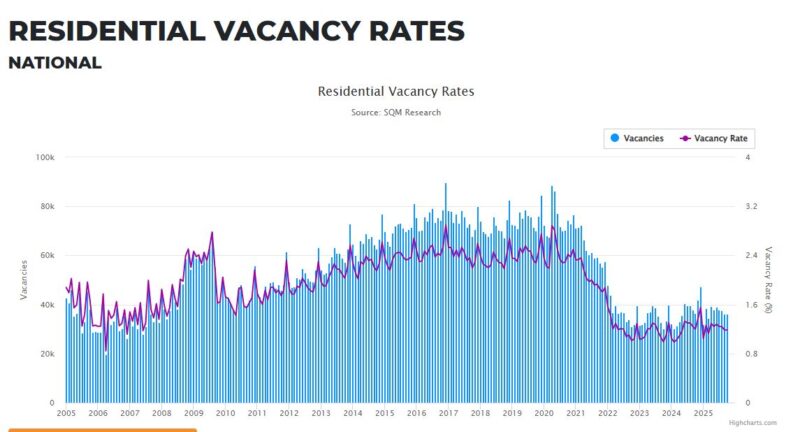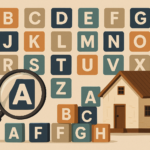
Key takeaways
Australia’s national residential vacancy rate remained steady at 1.2% in October 2025, unchanged from September.
The total number of residential vacancies rose slightly to 36,152 dwellings, up 106 from the previous month, suggesting that while rental market conditions remain tight, some cities are showing early signs of easing pressures.
SQM Research released its latest data on residential property vacancy rates.
Australia’s national residential vacancy rate remained steady at 1.2% in October 2025, unchanged from September.

The total number of residential vacancies rose slightly to 36,152 dwellings, up 106 from the previous month, suggesting that while rental market conditions remain tight, some cities are showing early signs of easing pressures.
Vacancy Rates - October 2025
| City | Oct 2024 Vacancies | Oct 2024 Vacancy Rate | Sep 2025 Vacancies | Sep 2025 Vacancy Rate | Oct 2025 Vacancies | Oct 2025 Vacancy Rate |
|---|---|---|---|---|---|---|
| Sydney | 10,874 | 1.5% | 9,617 | 1.3% | 9,553 | 1.3% |
| Melbourne | 9,052 | 1.7% | 9,407 | 1.8% | 9,713 | 1.8% |
| Brisbane | 3,580 | 1.0% | 3,329 | 0.9% | 3,391 | 1.0% |
| Perth | 998 | 0.5% | 1,362 | 0.7% | 1,304 | 0.7% |
| Adelaide | 915 | 0.6% | 1,207 | 0.8% | 1,215 | 0.8% |
| Canberra | 1,059 | 1.7% | 970 | 1.6% | 860 | 1.4% |
| Darwin | 349 | 1.4% | 171 | 0.7% | 181 | 0.7% |
| Hobart | 179 | 0.6% | 107 | 0.4% | 107 | 0.4% |
| National | 36,846 | 1.2% | 36,046 | 1.2% | 36,152 | 1.2% |
Source: SQM Research
Capital city highlights
Sydney:
Vacancy conditions remained steady at 1.3%, with 9,553 vacancies recorded.
Tenant demand continues to be strong amid limited new rental supply, though rent growth moderated slightly over the month.
Melbourne:
Vacancy rates held firm at 1.8%, with 9,713 vacancies.
The market remains broadly balanced, reflecting a steady inflow of new listings alongside consistent tenant activity.
Brisbane:
The vacancy rate remained tight at 1.0%, with 3,391 vacancies.
While conditions are still very constrained, recent data suggests a gradual easing in rental price growth.
Perth:
Perth’s market continues to rank among the tightest nationally, with the vacancy rate unchanged at 0.7%, representing 1,304 dwellings.
Ongoing supply shortages are keeping rental competition elevated.
Adelaide:
Vacancy levels remained exceptionally low at 0.8%, with 1,215 vacancies.
Limited new stock continues to maintain upward pressure on rents.
Canberra:
Vacancies fell to 1.4%, down from 1.6% the previous month, with 860 dwellings available.
The local market remains seasonally active, ahead of the end-of-year turnover.
Darwin:
A slight increase in rental listings saw the vacancy rate lift to 0.7%, representing 181 properties.
Despite the rise, Darwin remains one of the tightest rental markets in the country.
Hobart:
Hobart’s vacancy rate held at a record-low 0.4%, confirming its position as the tightest capital city market, with extremely limited available rental stock.
Advertised rents analysis
National advertised rents softened through early November, with combined rents up 0.2% over the past 30 days but remaining 4.6% higher year-on-year, indicating that while rental growth has slowed, overall market conditions remain tight amid ongoing supply shortages.
The national combined rent average now stands at $664.77 per week, while the capital city average sits at $755.65 per week, reflecting modest easing in house rents after several months of steady increases.
Nationally, house rents rose 1.9% for the month and 6.1% over the year, while unit rents declined 0.9% monthly but are still up 4.6% annually, suggesting stabilisation in demand for medium- and high-density dwellings.
Sydney:
Combined rents rose 1.4% for the month but remain 5.7% higher year-on-year, with house rents averaging $1,118.63 per week.
Melbourne:
Combined rents declined 0.9% over the month yet are 3.4% higher over the year, supported by ongoing leasing activity in the inner suburbs.
Brisbane:
Combined rents fell 0.2% for the month and 6.7% annually, underpinned by continued population inflows and strong demand for family homes.
Perth:
Combined rents dropped by 0.2% month-on-month, though remain 5.1% higher year-on-year, reflecting the city’s ongoing undersupply despite short-term volatility.
Adelaide:
Combined rents rose 0.8% in October and are 3.1% higher over the year, with house rents averaging $680.65 per week.
Canberra:
Combined rents increased 2% for the month and 2.8% over the year, driven by a rebound in house leasing activity ahead of the summer turnover period.
Darwin:
Combined rents lifted 0.3% for the month and 8.1% year-on-year, continuing its trend as one of the strongest annual performers.
Hobart:
Combined rents slipped 0.3% monthly but remain up 9.1% annually, consistent with ongoing stock shortages and limited new rental listings.
Weekly rents index
Sydney
| Property Type | Rent ($) | Weekly change | Monthly change | 12 Months change |
|---|---|---|---|---|
| All Houses | $1,118.32 | 0.68 | 1.8% | 6.6% |
| All Units | $728.12 | 1.88 | 0.6% | 5.0% |
| Combined | $866.37 | 1.39 | 1.2% | 5.8% |
Source: SQM Research
Melbourne
| Property Type | Rent ($) | Weekly change | Monthly change | 12 Months change |
|---|---|---|---|---|
| All Houses | $766.94 | -1.94 | -0.7% | 2.8% |
| All Units | $562.56 | -0.56 | -1.3% | 3.5% |
| Combined | $647.97 | -1.14 | -1.0% | 3.3% |
Source: SQM Research
Brisbane
| Property Type | Rent ($) | Weekly change | Monthly change | 12 Months change |
|---|---|---|---|---|
| All Houses | $778.40 | 0.60 | 0.3% | 7.9% |
| All Units | $613.20 | 0.80 | -0.3% | 5.9% |
| Combined | $704.02 | 0.69 | 0.0% | 7.1% |
Source: SQM Research
Perth
| Property Type | Rent ($) | Weekly change | Monthly change | 12 Months change |
|---|---|---|---|---|
| All Houses | $833.90 | 7.10 | 0.1% | 6.3% |
| All Units | $651.29 | 3.71 | 0.0% | 5.4% |
| Combined | $758.37 | 5.70 | 0.0% | 6.0% |
Source: SQM Research
Adelaide
| Property Type | Rent $) | Weekly change | Monthly change | 12 Months change |
|---|---|---|---|---|
| All Houses | $679.07 | -1.07 | 0.9% | 1.9% |
| All Units | $521.57 | 3.43 | 1.2% | 4.5% |
| Combined | $625.80 | 0.45 | 1.0% | 2.7% |
Source: SQM Research
Canberra
| Property Type | Rent ($) | Weekly change | Monthly change | 12 Months change |
|---|---|---|---|---|
| All Houses | $791.62 | 8.38 | 3.5% | 2.9% |
| All Units | $576.26 | 1.74 | 2.2% | 3.0% |
| Combined | $673.59 | 4.74 | 2.8% | 2.8% |
Source: SQM Research
Darwin
| Property Type | Rent ($) | Weekly change | Monthly change | 12 Months change |
|---|---|---|---|---|
| All Houses | $760.67 | 9.33 | 2.3% | 5.8% |
| All Units | $574.74 | -3.74 | -0.5% | 9.9% |
| Combined | $650.73 | 1.60 | 0.8% | 8.0% |
Source: SQM Research
Hobart
| Property Type | Rent 9$) | Weekly change | Monthly change | 12 Months change |
|---|---|---|---|---|
| All Houses | $597.29 | 6.71 | 0.5% | 11.1% |
| All Units | $492.65 | 6.35 | 2.8% | 7.6% |
| Combined | $555.54 | 6.57 | 1.3% | 9.9% |
Source: SQM Research
National
| Property Type | Rent ($) | Weekly change | Monthly change | 12 Months change |
|---|---|---|---|---|
| All Houses | $742.00 | -2.00 | 2.1% | 5.4% |
| All Units | $577.00 | 4.00 | 0.9% | 4.2% |
| Combined | $665.55 | 0.78 | 1.6% | 4.9% |
Source: SQM Research
Cap City Average
| Property Type | Rent ($) | Weekly change | Monthly change | 12 Months change |
|---|---|---|---|---|
| All Houses | $883.00 | 4.00 | 0.5% | 5.5% |
| All Units | $650.00 | 3.00 | 0.3% | 4.8% |
| Combined | $759.19 | 3.47 | 0.4% | 5.2% |
Source: SQM Research
Commentary
The national vacancy rate holding at 1.2% suggests the rental market remains very tight, with little sign of meaningful supply increases.
While some capitals are showing temporary easing in rent growth, underlying conditions remain undersupplied, particularly in cities such as Perth, Adelaide, and Hobart.
Brisbane continues to attract strong demand from interstate migration, while Melbourne and Canberra appear to be stabilising following recent surges in new rental listings.
Overall, we expect rental conditions to remain tight through the summer months, with only a modest increase in vacancies likely in early 2026.














